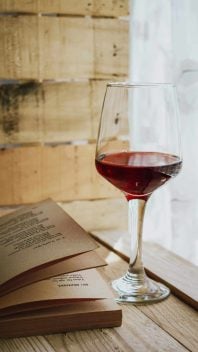Before wine, there was cinema for Edoardo Ventimiglia, and a job far from the vineyards for his wife, Carla Benini, the owners of the Sassotondo winery. He was a documentary filmmaker from Rome, and she was an agronomist from Trentino, but they changed both their lifestyle and career, focusing entirely on the Tuscan region of Pitigliano.

Amiata Mountain behind Sassotondo's vineyards
Cinema and paperwork
Edoardo comes from a family that has worked in cinema for three generations. His grandfather was Edoardo Ventimiglia, "a photography enthusiast who was actively involved in the silent film era in Catania. He then travelled the world and worked with Alfred Hitchcock as a cinematographer." But that’s not all: "He directed *Cines* and was one of the founders of the *Centro Sperimentale di Cinematografia* (Experimental Cinematography Centre). After returning to Catania in 1909 due to the earthquake, he founded the eponymous Sicilian football team, of which he was president." Before founding the company with her husband, Carla worked on major international projects, a job "more about paperwork than the land."

Scotland in Tuscany
In 1990, Edoardo explains, "we stumbled upon the sale of a farm, which we bought." Just one hectare of vineyard, a house to renovate, and 70 hectares of land, but Pitigliano captivated them thanks to a "landscape that looked like a Scottish moor." Several figures from the wine world played a key role in the winery’s story, including Gianvittorio Baldi, "a film producer but also a major wine producer, who introduced us to oenologist Attilio Pagli, who helped us take our first steps in production."
From sommelier to winemakers
However, their encounter with wine dates back a few years earlier, in Rome. "In 1988, we took the AIS sommelier course in Rome, where Daniele Cernilli and Sandro Sangiorgi were among the instructors, and we tasted wines in tulip-shaped glasses similar to those used for grappa." It was also then that Gambero Rosso entered their lives. "During the course, the first edition of the Guida Vini d'Italia was presented. It’s a huge pleasure to receive the *Tre Bicchieri* award for the Maremma Toscana Ciliegiolo San Lorenzo '21, because we are very attached to that guide and the memory."

In 1997, they harvested the grapes from their first vintage of their *Ciliegiolo* cru from the San Lorenzo vineyard, a grape variety that became central to the winery’s production. "Attilio Pagli tasted it and was impressed by the quality. In 1999, at Benvenuto Brunello, he told us, ‘I have a proposal for you: instead of planting international varieties, let’s plant only *ciliegiolo*.’ We agreed, but instead of buying nursery stock, we did a massal selection from the San Lorenzo vineyard." For *Bianco di Pitigliano*, the story is quite different: "It’s a stubborn project of mine and my wife’s, not even Attilio wanted it. It’s one of Italy’s oldest DOCs." However, today it is labelled under the IGT Toscana designation. "Unfortunately, it’s still an undervalued designation, which could produce mineral, long-lasting wines with character."
The farming method
The vineyards have been farmed organically since 1994: "We are among the first companies, if not in Italy, at least in Tuscany, to be certified," says Edoardo. But in 2007, they shifted focus. "On the advice of some producer friends, I took courses attended by Nicolas Joly. I was concerned about the esoteric aspects of biodynamic farming, but after embarking on this path, the results came in terms of production and quality. So much so that my colleagues at the winery nicknamed the preparations ‘holy water,’" Carla says. "Even today, I wouldn’t say my company is biodynamic. I follow what I’ve learned in a secular way, especially the aspects that concern the holistic nature of this approach. The goal is to reach a balance I would describe as ‘homeostasis.’"

However, don’t call them "natural wines." "I use indigenous yeasts. In our cellar carved into the tuff, there are yeasts that allow spontaneous fermentation without any problems. That said, I’m not a hardliner: if I needed to, I would use industrial yeasts. But I don’t like the term ‘natural.’ The word ‘natural’ should refer to nature, to the vineyard, but everyone seems more interested in the winemaking process. It seems to me that this bubble, which is destined to burst, has distanced young people from the vineyard. If I talk at a tasting table about micro-zoning and selections, they get bored, but if I mention amphorae, their eyes light up. My eyes light up when I’m in the vineyard, among the vines."


 Why not every trattoria should be written about
Why not every trattoria should be written about Brigitte Bardot’s final rosé: the wine that marks the end of an icon
Brigitte Bardot’s final rosé: the wine that marks the end of an icon What you need to know about Italy's new decree on dealcoholised wine
What you need to know about Italy's new decree on dealcoholised wine Why Arillo in Terrabianca's organic approach is paying off
Why Arillo in Terrabianca's organic approach is paying off





